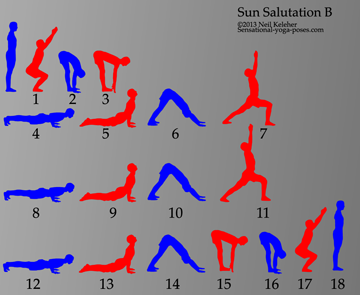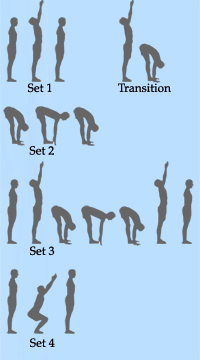An Introduction to Ashtanga Style Sun Salutations
Learning the Number of Movements Can Help!
Sun salutations ("Surya Namaskara" in Sanskrit)are used in yoga practices like Ashtanga yoga as a means of warming up and also as a means of focusing the mind.
They can also be considered a type of prayer.
There are two types of sun salutation in the Ashtanga Yoga system:
Knowing the Numbers
Knowing the number of moves in each sun salutation is handy because it can help to tell you if you've done it right or wrong.
If, for example you finish doing Sun Salutation A but you've only counted 8 or 9 moves then you know you've missed something out.
Likewise if your finish Sun Salutation B after only 14 moves, then again you know you've done something wrong.
Breathing Movements-Inhales and Exhales
Each movement in a Sun Salutation is accompanied by either an inhale or an exhale. Because odd numbered moves are done while inhaling and even numbered moves are done while exhaling, this may help you to remember the moves easier.
In general odd numbered moves, which are all inhales, tend to be upwards moving and chest expanding. Even numbered moves, exhales, tend to be downwards moving.
I've colored inhale movements red (working) and exhale movements blue (relaxing.)
Chaturanga (move number 4), which I like to think of as Crocodile, is moved into with an exhale, since the chest and head are lowered as the arms are bent.
Upward Dog (5) is moved into with an inhale since the head and chest lifts.
Downward Dog (6) is moved into with an exhale since the head and chest move down.
Common Mistakes
Sun A
A common mistake that I see people make when doing either sun salutation is in the transition from Downward Dog to standing. They tend to forget movement 7 (number 15 in the B Salute,) the reaching forwards with the spine movement.
It may be helpful to remember that since you move in to Downward Dog with an exhale, you should come out of it with an inhale. Hence, chest forwards (7). Afterwards you exhale and bend down (8).
Sun B
Often times when first learning to do Sun Salutation B I see students forget to do the Chaturanga and Upward Dog movements (movements 8 and 9, 12 and 13) after doing Warrior 1 (movements 7 and 11). Instead they go straight to Downward Dog.
One very cheesy memory aid: imagine that you are a warrior, you've shot your arrow and you have to get down... and so you lay on the ground in Chaturanga.
One final note,when starting and finishing Sun Salutation B, remember to bend your knees. Even though your hips are sinking, your arm are lifting and so in both cases this move is done with an inhale.
Breaking Sun Salutations Down into Blocks
To learn a Sun Salutation, break it down into blocks of movements.
- As an example you can practice lifting the arms and lowering them in time with your breath (Set 1.)
- You can also practice reaching your chest forwards and down (Set 2.)
You can repeat these sets of movements, doing them in time with your breath, and then add them together.
- As an example you can lift your arms, bend forwards, reach your chest forwards, then bend forwards, then stand up and lift your arms and then lower your arms (Set 3.)
- When getting ready to do Sun Salutation B you can practice lifting your arms while bending your knees at the same time. Then stand up and lower your arms. (Set 4.)
Three Special Poses
Three postures that you may do well to practice individually are
Chaturanga,
Upward Facing Dog and
Downward Facing Dog (movements 4, 5 and 6 in Sun Salutation A).
Sun Salutation B-Creating Heat
The B Sun Salutation in Ashtanga Yoga is eight movements longer than the A Sun Salutation and has two additional yoga poses: Chair Pose and Warrior 1.
You may find it easier to think of Chair Pose as a replacement for movements 2 and 9 in Sun Salutation A.
- Instead of lifting the arms while keeping the legs straight, lift the arms and bend the knees at the same time.
- And then straighten your knees again when you bend forwards.
When doing Warrior 1 remember:
- Do it with the right leg forward first, followed by Chaturanga, Upward Dog, Downward Dog.
- Then do Warrior 1 with the left leg forwards, followed once again by Chaturanga Dandasana, Upward Facing Dog and then Downward Facing Dog.
You can practice these two yoga postures individually so that you get a feel for them. You may then find it easier then to move in and out of them because you know where you are going or what you are trying to do.
Because of the two warrior poses (left side and right side) Sun Salutation B has 2 extra "Chatarunga-Upward Dog-Downward Dog" mini-sequences. As a result, doing Sun Salutation B can either warm you up or tire you out. However, once you've learned the movements you may find that you can practice while leading with your breath.
This can make breathing easier as well as make doing the Sun Salutation itself easier.
5 Breaths in Downward Facing Dog
An Ashtanga Yoga practice normally starts with 3 to 5 Surya Namaskara A's and 3 to 5 Surya Namaskara B's. You may want to do more when practicing in a cold environment or if you like "The Exercise." You might also like varying the speed at which you do them, noticing how you feel when you do them with a faster breath as opposed to a slower breath.
I almost forgot,
- in Sun Salutation A hold, Downward Dog (movement 6) for about 5 inhales and 5 exhales.
- In Sun Salutation B only hold the final Downward Dog (Movement 14) for 5 Breaths.
Published: 2012 03 28
Updated: 2020 10 28




